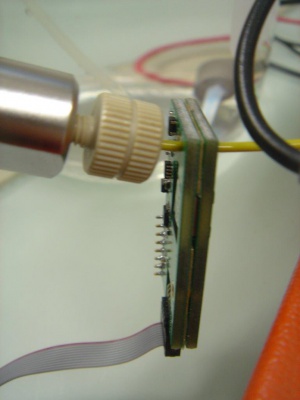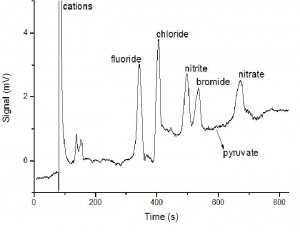Difference between revisions of "ET125ヘッドステージを用いたC4Dイオンクロマトグラフィー"
| Line 8: | Line 8: | ||
eDAQ [http://www.edaq.com/ET125 ET125 C4D チューブヘッドステージ] は、イオンクロマトグラフィー(IC)や高速液体 | eDAQ [http://www.edaq.com/ET125 ET125 C4D チューブヘッドステージ] は、イオンクロマトグラフィー(IC)や高速液体 | ||
クロマトグラフィー(HPLC)用の非接触電導度検出器とし | クロマトグラフィー(HPLC)用の非接触電導度検出器とし | ||
| − | + | て開発されました。このヘッドステージは IC や HPLC の | |
| + | 標準外径の 1/16インチ(1.6 ㎜)、または外径1/8 インチ (3.2 ㎜)のチューブを直接差し込み分離物質の電導度分析をすることができます。 | ||
| − | + | 図 1 のように、検出器のヘッドステージはできるだけ分離 | |
| + | カラムの出口近くに取り付けます。デッドボリュームを少なくすれば、 | ||
| + | ピークの幅も広がらず良好なクロマトグラムが得られます。 | ||
A sample containing 1 mM fluoride, chloride, nitrate, bromide, pyruvate and nitrate was analysed; the chromatogram is shown in Figure 2. | A sample containing 1 mM fluoride, chloride, nitrate, bromide, pyruvate and nitrate was analysed; the chromatogram is shown in Figure 2. | ||
Revision as of 15:27, 27 February 2014
DAQ C4D システムをイオンクロマトグラフィー/HPLC 用の 1/16" 径チューブに直接つなぎ、6種類の陰イオンを 分析します
はじめに
eDAQ ET125 C4D チューブヘッドステージ は、イオンクロマトグラフィー(IC)や高速液体 クロマトグラフィー(HPLC)用の非接触電導度検出器とし て開発されました。このヘッドステージは IC や HPLC の 標準外径の 1/16インチ(1.6 ㎜)、または外径1/8 インチ (3.2 ㎜)のチューブを直接差し込み分離物質の電導度分析をすることができます。
図 1 のように、検出器のヘッドステージはできるだけ分離 カラムの出口近くに取り付けます。デッドボリュームを少なくすれば、 ピークの幅も広がらず良好なクロマトグラムが得られます。
A sample containing 1 mM fluoride, chloride, nitrate, bromide, pyruvate and nitrate was analysed; the chromatogram is shown in Figure 2.
The method used was similar to experiments previously published, except contactless (as opposed to contact) conductivity detection was used: Separation of anions by ion-interaction chromatography with a novel cationic/zwitterionic eluent; Zhu Yan, Ling Yanyan, James S. Fritz, Paul R. Haddad; Journal of Chromatography A, 1020 (2003) 259–264
Equipment Required
- C4D hardware unit, either:
- ER225 C4D Data System including PowerChrom software
- ER815 C4D Detector with third-party data acquisition system
- ET125 General Purpose C4D Headstage
- HPLC instrument
Conditions
- Sample: A solution of 1 mM fluoride, chloride, nitrate, bromide, pyruvate and nitrate, dissolved in water.
- Buffer: 98.75% water, 1.25% methanol, 2.5mM tetrabutylammonium hydroxide (TBAOH) and 5mM 3-(N-morpholino)-propane sulfonic acid (MOPS).
- Separation column: Macherey-Nagel, Nucleosil 120.5 C18, part 720041.46.
- C4D settings
- frequency = 800 kHz
- amplitude = 80 A
- headstage gain OFF.
- Data recording:
- lowpass Filter = 10 Hz
- range = 20 mV
- sampling rate = 1000 data points per second.

